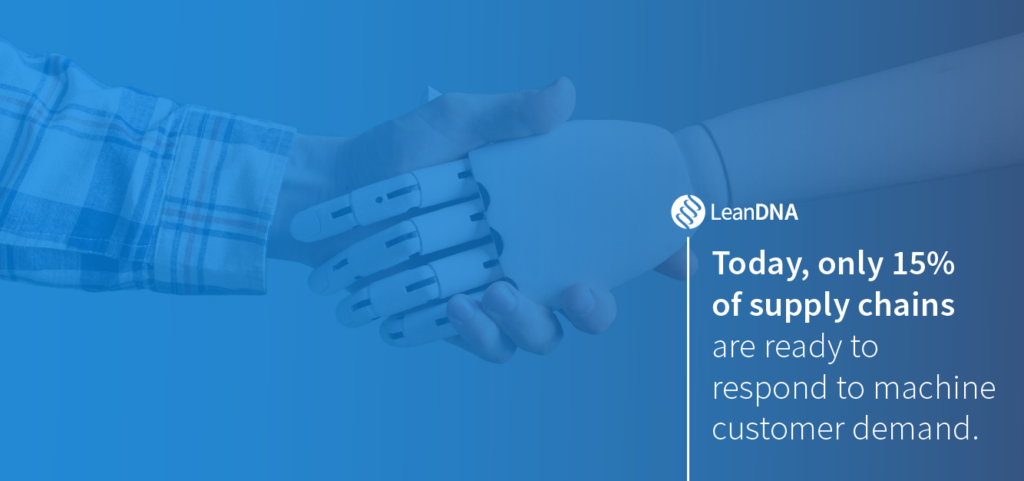More than 60% of supply chain manufacturers are working on or planning to design their machine response strategy over the next three years. In Gartner's 2022 report, surveys show the necessity of preparing the supply chain for machine customers. With projections putting these customers at the forefront of revenue for manufacturers in the next ten years, it is essential to build a digital foundation that encompasses the needs of operations catering to these customers. To find the best way to do this, we look to Gartner’s best supply chain practices.

Today, only 15% of supply chains are ready to respond to machine customer demand. Considering the increasing relevance of this group of consumers, this is a low percentage of manufacturers that will be ready to face future demand. A digital foundation is essential to accommodate the future of the market and by following Gartner's best supply chain practices, supply chain leaders can prepare their teams for what lies ahead.
The 6 necessities for successful digital transformation identified are:
-
An Agile and Resilient Supply Chain
The Gartner report states that “64% of supply chain leaders consider increasing supply chain agility and resilience the most critical action for supply chain transformation.” This is no surprise considering the tumultuous state of the supply chain in recent years. In an era of no guarantees, how can you increase the guarantee of a smooth-running supply chain?
To create a more agile and resilient supply chain, manufacturers need to have real-time, up-to-date data from a reliable source so they can make accurate business decisions. This is best achieved by using advanced software designed to translate real-time data into actionable tasks.
-
Accessible, Secure, and Unbiased Supply Chain Data
Data security is crucial for complex, global manufacturers. Security protocols should be designed so that the addition of machine customers does not compromise the environment for already existing consumers. Data should be accessible for teams but secure from hackers.
-
Automating Repetitive Processes and Decision-Making
Most manufacturers consider automation to be the most critical action for digital transformation in the supply chain. Automation allows for a fast-paced, efficient supply chain driven by data. Not only does this reduce human error on repetitive tasks, but it significantly reduces the risk of employee burnout. When organizations can automate these manual processes, they free up employees' time to work on more engaging tasks and make better faster decisions.
-
A Digital Platform to Integrate with Suppliers
Visibility in the supply chain is one of the most crucial elements. Without integrating technology with business partners, a huge part of your supply chain paths are in the dark. Modern manufacturers must be proactive and quick to adapt with the plethora of disruptions that occur on a daily basis in the global supply chain, enhanced visibility is critical. Through a digital platform, manufacturers can instantaneously connect with consumers and even further, be able to fully digitize transactions. Digital platforms designed to integrate with partners will also help move beyond purchase orders as the sole source of demand to “sense the flow of materials in near real-time.”
-
Attracting Digitally Savvy Talent—and Retaining this Talent
No matter where on the digital transformation scale a business is, the matter of the fact is that most manufacturers today are using some form of digital tools to function. The more tech-savvy the talent organizations can attract (and retain), the better off their business will be. It is also important for companies to train their current supply chain staff. Digital updates will likely be introduced organization-wide, and the culture of an organization should be designed so that all employees feel comfortable learning and utilizing the tools that are available to them.
-
Upending Customer Experience Management Practices
Gartner’s report states that “20% of supply chain leaders say overhauling customer experience management is key to preparing for machine customer demand.” They also explain that the key to using the role of the supply chain for customer experience management (CX) is to leverage the masses of data from machine customers. Supply chain leaders across the globe should integrate more CX roles to utilize employees to serve a more complicated customer landscape.
To learn more about the return on investment (ROI) of advanced supply chain analytics, read about it here.
LEANDNA PREPARES MANUFACTURERS FOR MACHINE CUSTOMERS
LeanDNA helps businesses achieve the necessities for successful digital transformation, by connecting suppliers, sites, and systems to establish a synchronized supply chain.

